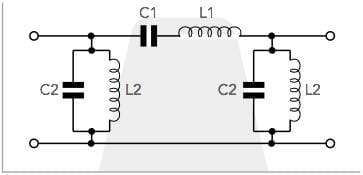Constant-K LC Band Pass Filter Circuit Design & Calculations
Design considerations, circuit and formulas for a constant-k LC band pass filter for RF applications.
Home » Radio & RF technology » this page
Constant K Filter Includes:
Constant-k filter
Simple LC LPF design
LC HPF design
LC band pass filter design
Filter basics includes::
RF filters - the basics
Filter specifications
RF filter design basics
High & low pass filter design
Constant-k filter
Butterworth filter
Chebychev filter
Bessel filter
Elliptical filter
Band pass filters using LC components, i.e. inductors and capacitors are used in a number of radio frequency applications. These filters enable a band of frequencies to be passed through the filter, while those in the stop band of the band pass filter are rejected.
These filters are typically used where a small band of frequencies need to be passed through the filter and all others rejected by the filter.

LC bandpass filter design basics
One of the easiest and most straghtforward forms of filter to design is the constant-k filter. Like the high pass filters and the low pass filters, there are two topologies that are used for these filters, namely the Pi and the T configurations. Rather than having a single element in each leg of the filter as in the case of the low pass and high pass filters, the band pass filter has a resonant circuit in each leg. These resonant circuits are either series or parallel tuned LC circuits.


LC bandpass filter design equations
The equations below provide the values for the capacitors and resistors for a constant-k filter. As this constant-k filter is a band pass filter there are two cut off frequencies. One at the low edge of the pass band and the other at the top edge of the pass band.


Where
Z0 = characteristic impedance in ohms
C1 and C2 = Capacitance in Farads
L1 and L2 = Inductance in Henries
f1 and f2 = Cut off frequencies in Hertz
Further details
When designing and building a bandpass filter there are several guidelines and tips that can help ensure the best performance.
- Component choice: The choice of components for any RF filter is important for its performance. For a bandpass filter it is even more critical because the circuit comprises six components rather than just three in the case of a similar low pass or high pass LC filter. As a result of this, close tolerance components should be used to ensure that the required performance is obtained. It is also necessary to check on the temperature stability to ensure that the RF filter components do not vary significantly with temperature, thereby altering the performance.
- Filter layout: The choice of components for any RF filter including a bandpass filter can be
Care must be taken with the layout of the RF filter, especially when the RF filter is used for high frequencies. Capacitive and inductive coupling are the main elements that cause the filter performance to be degraded. Accordingly the input and output of the filter should be kept apart. Short leads and tracks should be used, Components from adjacent filter sections should be spaced apart. Screens used where required, and good quality connectors and coaxial cable used at the input and output if applicable.
The bandpass filter circuit is very straightforward, and the design equations enable a very easy solution to calculating the circuit values. Although the performance may not be totally optimal for some applications, it provides an excellent solution for many RF LC based bandpass filters.
 Written by Ian Poole .
Written by Ian Poole .
Experienced electronics engineer and author.
More Essential Radio Topics:
Radio Signals
Modulation types & techniques
Amplitude modulation
Frequency modulation
OFDM
RF mixing
Phase locked loops
Frequency synthesizers
Passive intermodulation
RF attenuators
RF filters
RF circulator
Radio receiver types
Superhet radio
Receiver selectivity
Receiver sensitivity
Receiver strong signal handling
Receiver dynamic range
Return to Radio topics menu . . .


